Don't wanna be here? Send us removal request.
Text
How would you talk someone into reading Saezuru?
I usually mess this up lol, rarely convince someone to read/ watch my favorites. How do you think of grabbing a line from a character summing up Yashiro like Misumi's "Your pride lies somewhere around your soles" to pique curiosity? To me this saying is so ingenious that it's carved into my brain. How about you? How do you do it?
#saezuru tori wa habatakanai#twittering birds never fly#saezuru#yashiro#囀る鳥は羽ばたかない#yoneda kou#question to fandom#yaoi manga
10 notes
·
View notes
Text
New cover of volume 9 of saezuru. Yashiro being tenderly touched by Doumeki. I hope that in volume 10 that hand no longer has a glove...

143 notes
·
View notes
Text
something I think more people need to understand is that rape culture has a very simple way to maintain the plausible deniability that enables mass support and investment, and that is the complete separation of the rhetorical construction of "The Rapist" and "The Pedophile" from any actual specific person who engages in sexual violence.
so often people do not believe that we could possibly live in a rape culture, they do not believe it could possibly be true that people do not care about children who were sexually abused-- they say but everyone hates rapists and pedophiles! but that's not really true. they hate the conceptual idea of The Rapist and The Pedophile, but do not actually oppose--in real world contexts, with real actual complicated people--the use of sexual violence to control, degrade, and otherwise abuse other people. they do not hate their friend who joked that their date "took some convincing" or their neighbor who publicly humiliated their adolescent child by telling their church group he was "caught" masturbating, or the cop who performs cavity searches or the guy who posted tips for "stealthing" online, or their uncle who says he "made some mistakes with women" when he was younger, or the person on social media publicly speculating about a stranger's sexual desires and sharing their nudes to degrade and humiliate them, or their granddad who was "falsely accused" of sexually abusing his daughter when "all he did" was leer and not touch, or their professor who has relationships with their students, or their acquaintance who recommends dating girls with "issues", girls who are "crazy", girls who are trans or fat or queer or have low self-esteem, because "they'll do anything", or the person they organize with who is so valuable to the movement but everyone kind of knows not to be alone in a room with them, or...
specific people who rape are usually not the deviant that most people already want a reason to expel from the community, they are the center of power and influence. they provide vital support or resources to people, they are likable and intimately connected with many people, they have an embedded role in the social fabric and many people benefit from it (whether economically, politically, spiritually, etc). Specific people who rape are incredibly buoyant. They are usually buoyed to places of power no matter how far they're attempted to be pulled down from that power, and most people see this and will cling to a person like this, defending them, because people who rape are the social equivalent to a life preserver, whereas people who have been raped are the social equivalent of an anchor-- no one wants to be dragged down by allying themselves with the person who was raped by the beloved person everyone loves and relies on.
On the other hand, The Rapist" and "The Pedophile" as cultural tropes are treated very differently from specific people who have raped others. "The Rapist"/"The Pedophile" is often a racialized, gendered, and classed archetype that exists to be the ideological load bearing pillar of rape culture, to reinforce the belief (against the weight of evidence) that rape is something committed by Deviant Others who can be identified and expelled from social life. When sexual violence is not understood as one of many possible tactics of control and is instead as the result of the uncontrollable desire of innate deviants, then accusations do not even require there to be a specific person who was harmed by a specific act. All you need is evidence of "deviance" and all the justified anger at sexual violence can be offloaded onto whatever scapegoat you want.
In fact, within rape culture, harassment campaigns are much more successful than any actual instance of a survivor asking for support. That is no coincidence either! Rape culture hates survivors! But because in harassment campaigns there is no actual survivor speaking up, rape culture's default of disbelieving specific, actual survivors is never triggered, and so the accusation becomes perceived as more credible because there is no victim to discount.
If there is no actual specific instance of someone engaging in sexual abuse of another specific person, there are no details to question and pick apart ("but why was she naked if she didn't want to have sex?" "was he really raped if he had an orgasm?" "how do you know it was sexual? adults have to bathe their kids" "why did she post that photo if she didn't want it shared?" "I've never seen that side of him!" "maybe you misunderstood" "maybe she didn't hear the safeword" "why wait until now to bring it up?") and no demands of the public that implicate them and demand change from them (are you sending survivors funds to help them move out? to help them afford therapy? are you examining why you didn't notice it was happening or didn't believe it could be true? are you able to understand that as part of this person's community, you failed to protect them, and that actual restorative justice involves you changing your beliefs and behavior too? that it's not just about rehabilitating the person who raped someone?)
If there's no survivor, then the imagined victim can be perfect, innocent, and worthy to rally around. The imagined victims are only good and only hurt and have no problematic opinions about anything (no opinions at all! so they can be imagined to believe whatever you believe), no burdensome expectations of you, no resentment towards you.
Focusing on identifying "The Rapist" as a deviant instead is so easy; it only requires condemning someone who you probably either already dislike or a complete stranger who has no direct connection to your life. It's so much easier to pin responsibility for the entire (abstracted) concept of Rape onto someone you already hate and is already a social outcast and show how much you're "against rape" by venting all your anger and fantasized violence against them. It feels good too! the way righteous anger always does. It can be energizing when a whole community comes together to hate the same person.
Supporting actual survivors does not feel energizing, it feels exhausting. It requires so much work and effort, and you don't feel righteous while you do it, you may even feel ashamed, frustrated, deeply sad, resentful, angry, hopeless, or emotionally numb. It enters the deepest parts of your consciousness and you find it hard to breathe during certain scenes in movies, seeing certain arguments play out in the news cycle. It changes you, too, and that is the point.
We want to be against rape culture, because we want to be good people. but we don't want it to be hard.
I think this reality is the reason why a lot of young organizers think they can throw themselves into restorative justice and then find themselves completely burnt out a few months or a year later. People start thinking it'll be energizing, and then have to contend with the reality of what is, essentially, providing material support for disabled people whose health and capabilities have been permanently decreased from trauma. Some folks think they're gonna be "fixing things" so everyone can continue their reliance on the person who raped someone and the survivor can "move on" and everything can be "restored."
And then (if they're serious and not just performing at activism) they are inevitably faced with the terrifying reality of trying to make ends meet, with cobbling together strategies to meet community needs outside of the person who everyone relies on. they are faced with this person who raped someone losing interest after a few meetings and deciding "the accountability process" is dragging on too long and interrupting "more serious things than one person's emotions." they are faced with trying to get more people involved supporting the acute needs of the survivor even when the survivor is "difficult" or "ungrateful", and realizing that no one wants to do it. it is overwhelming to realize how deep the roots of rape culture run through everything, how much stability is upturned when you uproot any structures and beliefs that rely on rape culture. it is deeply demoralizing when you realize nothing can change without collective effort and very few care enough to do it.
It's so much easier to do nothing and pretend you don't know what happened. It's so much easier to decide it doesn't have anything to do with you and maybe this is something the survivor should "work out" with the person who raped them. It's so much easier to not try.
that's the function of rape culture. and we are all implicated in it.
6K notes
·
View notes
Note
Is Nanahara in love with Yashiro? Dare we call that 'love'? Attraction mixed with affection maybe?
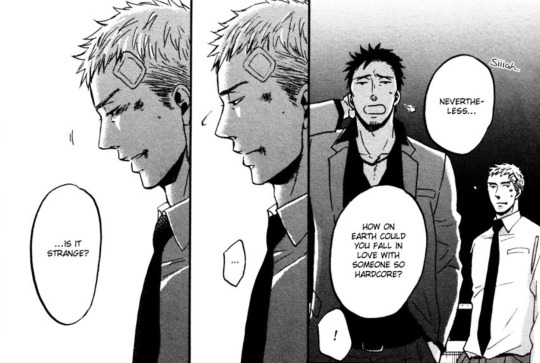

It’s hard to answer in a straightforward way for me, because I think that Yoneda often gives enough hints to make things interesting, but at the same time there is a level of ambiguity due to the fact that these people aren’t going to admit easily or even recognize their feelings or act on them when it comes down to actually pursuing same sex relationships in any meaningful way. There are various parallels between Nanahara and Ryuuzaki in this regard, but also substantial differences, and damn if, in going back to check the translation when I was taking few screenshots to put here, I didn’t almost tear up again when Ryuuzaki tells Nana about nineteen years old Yashiro and how he believes that no matter his ability to be cunning and make the most money, Yashiro shouldn’t even be in the yakuza. The Italian translation of this dialogue in chapter 17 conveys more of Ryuuzaki’s emotions and his exasperation than nobody else seems to have predicted this outcome: so instead of the scans version “What does someone like you knows?”, in the version I have Ryuuzaki says: “Why the fuck you guys can’t see it?”. And I suggest that it is generally better to check the official translations especially when it comes to volume 3!

If Ryuuzaki’s anger is also directed at himself for falling in Hirata’s trap, and he shows genuine worry for Yashiro as a person, the discovery that their kumicho has ordered Yashiro’s death is shattering and hits very hard poor Nanahara, because he genuinely believed in the principles that the yakuza seems to be based on as a familiar system of mutual protection. And I think it is important to look at his reactions here in chapter 17, his backstory in chapter 18 and later when he is reunited with Yashiro and he takes a bullet to protect him in chapter 20, to have a better chance of understanding Nanahara’s feelings and his relationship with Yashiro. You ask if it’s love, or attraction mixed with affection, so you already guess that there is more to it than simply sexual curiosity and that puzzling physical attraction. And I also believe that there is deep affection born from years of proximity and loyalty - and Nanahara’s loyalty is one of his most genuine qualities and a rare thing to see in that world. Yashiro isn’t in my opinion even aware of what he did to inspire these feelings in others. I don’t think that Yoneda is content with just teasing us with hints about generically romantic feelings or sexual attraction, because the reality of human relationships, especially when we talk queer relationships in a patriarchal context, is more complicated and complex than following your heart or your dick. I really appreciate that there are many layers to this story to look at, even for a character like Doumeki that isn’t bothered by directly admitting to his feelings. And Nanahara and Doumeki understand each other on a certain level. But while Yashiro accepted to formalize his relationship with Nanahara under the terms of the yakuza ceremonies, he refused to do so with Doumeki even after he cut off his finger and that is a big clue about what Yashiro felt and what direction he didn’t want that particular relationship to go.
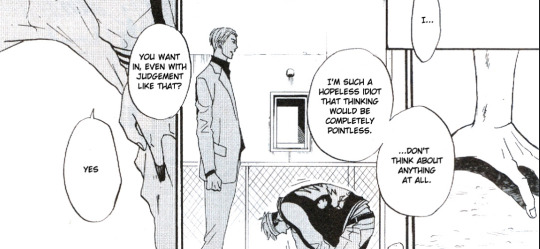
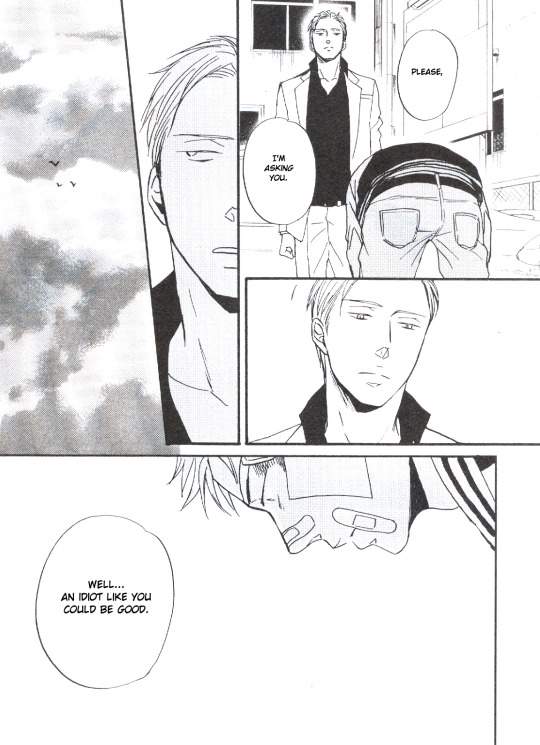
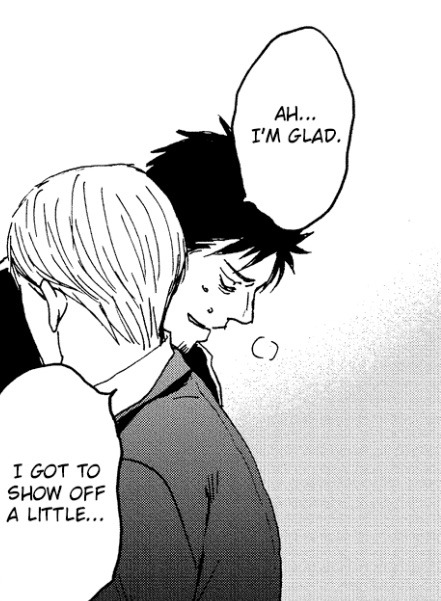
I think it’s important to look back at the circumstances that brought Nanahara to be Yashiro’s subordinate. How easily he admitted in the end that he wasn’t smart, when Yashiro only remarked that he wasn’t a good judge of character - being naive doesn’t mean being stupid. In this last scene, Yashiro makes his decision and takes Nanahara under his wing, willing to look after him and give him direction in the group so he isn’t taken advantage of again. But he also says something that really strikes Nanahara: “An idiot like you could be good”. To be good, to be recognized as having potential even in the face of Nanahara’s most great insecurity - believe me when I tell you I have a whole headcanon of Nanahara being told by parents and teachers that he was stupid over and over again and that really hurt him and he ended up believing it - and to find purpose and a place for himself in the world are not secondary things to a young person. And how the yakuza is formally defined, with Yashiro exchanging sake cups and thus formally recognizing the oyabun and kobun relationship I think mattered a lot to Nanahara. Kobun means literally something like ‘child status’ while the oyabun takes a ‘parent status’ with the implication of taking responsibility of mentorship and giving directions, making good decisions for their protégés and juniors, in a way that we see Nanahara interpret quite literally as a surrogate family. That is why he took Hirata’s betrayal harder than everyone else. He couldn’t even have imagined it. So I read in multiple ways Nanahara’s loyalty and his affection for Yashiro. I don’t think he is in love tho, because he doesn’t seem to want to change things in the relationship he has with Yashiro, he is content with being a subordinate and he took initiative only when he felt personally responsible and under Hirata’s manipulation. He might have suggestions or express his opinion freely, but for Nanahara is too important to know one’s place and to me that is indication of feelings that never really took the direction of being inescapable like a burning love that goes beyond affection and respect and true passion would imply. By the way I wish I knew better ways to communicate the different types of love in English, because I believe it should be easier to differentiate between familiar affections, romantic attraction, reciprocal care and so on, and I hope to convey correctly the different nuances. And if I put so much consideration into the linguistic aspects is because I think that the way we speak determines the way we think and our system of beliefs is also quite influential in how we build relationships with others.
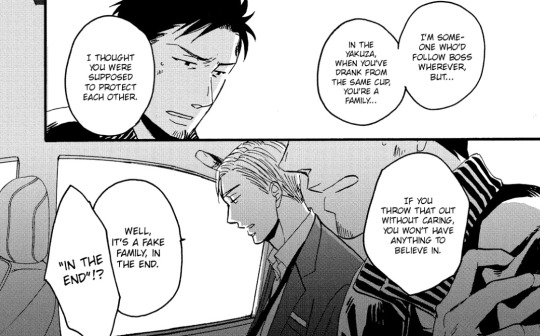
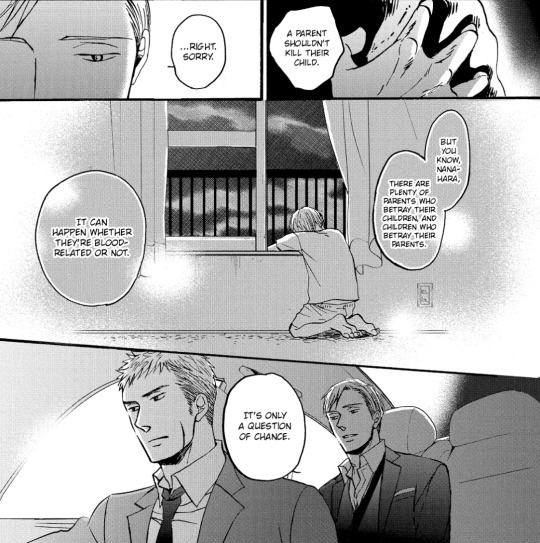
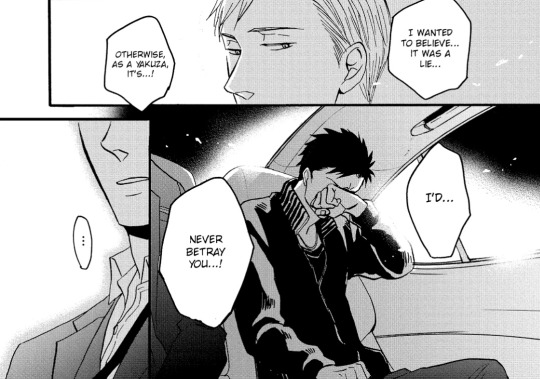
This scene in the car, although I have omitted parts of it and in particular the effects that Yashiro’s words have on Doumeki, is just so well done. It really shows how Yashiro’s disillusionment came so early he never quite knew any other reality that of being disillusioned: how could he innocently believe in anything or anyone even if he wanted to? Yashiro learned out of necessity to simply accept the worst reality behind fake promises and the promises of different systems of beliefs, he learned to not expect anything genuine or unconditional from others. And that type of loneliness is something that is hard to overcome and escape.
In conclusion, I think Nanahara definitely cares for Yashiro as a boss and as someone who gave him a place to belong and a purpose. He launched himself in front of him and took a bullet hoping to “show off” or, in the translation I have, hoping to demonstrate that he was good as Yashiro envisioned for him. But most of Nanahara’s attention is still focused more on the role than the actual person, he still trusts Yashiro to be the one to lead, create opportunities and build a group for them to be a family in the yakuza way. And it has been said and shown how he is attracted to women but he is turned on by the direct sexual displays that he got used to witnessing around Yashiro, but arousal doesn’t quite mean anything that much deeper in my opinion. And a personal consideration of mine also comes to mind, that I am glad that there is at least one person close to Yashiro that doesn’t want him in a possessive and erotic way, that Yashiro can rely on without worrying about being pushed outside of his almost nonexistent comfort zone regarding intimacy. If anything, I think that Ryuuzaki was the one closest to figuring out how the role put on Yashiro by Misumi wasn’t right for him, in opposition to both Nanahara and Doumeki. And the difference is apparently banal but maybe not so much, Ryuuzaki is the same age as Yashiro, and for a moment he looked at him and wondered - something Kageyama never did - while Misumi was much older and thought he knew what was best for Yashiro. Thank you for the ask and I hope this answer makes some sort of sense!
28 notes
·
View notes
Link
The lens case
Such a comprehensive analysis! The lens case embodies both the desire to be “seen” and the need to inhibit that desire from showing to the love interest. The lens case literally manifests Yashiro’s remark “People are full of contradictions”. To Kageyama, it was something he gives up. He couldn’t face the truth about himself that Yashiro proposed, so he cancelled it. His true self must be kept in the dark. To Yashiro, it is a memento of his desire to be loved and his determination to not let it be known, due to the thought that he doesn’t deserve to have love. Though he wanted Kageyama to “see” him, he couldn’t risk bearing the pain of rejection and retreated, which seemed unievitable because Kageyama would sure reject him. The same goes for Doumeki, though he’s completely different from Kageyama in terms of his feelings for Yashiro. All in all, the lens case represents Yashiro’s deepest part that must be hidden for him to be able to survive, the most contradictory part.
To Doumeki, it’s symbolic on many levels. The moment he steals the lens case, it becomes the symbol of his contradictions. He’ll be forsaken unless he covers up his feelings carefully. He “sees” Yashiro’s sincere heart, so what comes has to come. Doumeki has successfully torn down Yashiro’s coping mechanism to reveal that heart, Yashiro’s most essential, secret part is now in his palm. However, ironically, the more earger Doumeki wants to shower Yashiro with his love, the more Yashiro gets hurt, which is something Doumeki can’t comprehend at that moment. In addition, Doumeki’s tight clutch on the lens case also implies his upset and frustration over the love Yashiro once harbored for Kageyama, for all the pain Yashiro keeps for himself that Doumeki, no matter how much he wants to, can’t help.
Post-timeskip, Yashiro and Doumeki’s roles reverse. Now the lens case represents the love Doumeki restrains himself from showing, concealing it with a cold and ruthless facade. Doumeki has learned the lesson. If he wants Yashiro not to run away, he must not let Yashiro know his feelings. Tragically, it’s all the new, braver Yashiro needs to confirm to believe that he too deserves to be loved. It’s the validation Yashiro is seeking to believe that he is finally capable of growing beyond his trauma.
“Seeing and not seeing. Being seen and not being seen.” The ever classic hide-and-seek of love goes on and on.
#saezuru tori wa habatakanai#saezuru#twittering birds never fly#yashiro#doumeki x yashiro#lens#being seen#yoneda kou#bl
5 notes
·
View notes
Note
*Just some thoughts about Misumi's remark that Yashiro's pride is somewhere around the soles of his feet - such a perfect metaphor
"Pride" is the respect for yourself, for your own worth. Yashiro's "pride" is his humanity - kindness, the ability to empathize, to feel love, and his incredible resilience. On the other hand, the feet are one of the most sensitive parts of the human body, like the way most of these virtues are rather a fatal weakness that serves no good in the Yakuza world, so Yashiro conceals them to survive. As long as his humanity stays hidden under his soles, a kind of safe place, he'll survive on just fine. However, the way he protects his pride is rather "interesting" to Misumi. Yashiro calls for brutal, merciless trampling on himself to make sure his humanity doesn't surge to the surface, which is similar to how feet work - they trample and destroy. He preserves his pride by desperate attempts to paralyze and destroy it, a very classic Yashiro-esque style.
I wonder if this is relevant, but I'm saying it anw. Feet are also an important symbol in "A Perfect Day for Bananafish", where they stand for innocence and unmasked sincerity of a child that the main character, Seymour Glass, has lost. Yet deep down, Seymour bitterly knows the innocence he yearns for doesn't ever exist. "Innocence", or the state of a blank slate, is amoral, and in tandem with it since birth there's also destruction. The bare feet can both allow us to feel the world without putting on a facade, and also trample that same world.
In both works, the precious human part that can't be exhibited in their world lies under the feet. Love how authors play with the same object. I'm too deep in love with arts lol.
Can I ask why Misumi isn’t violent anymore? Why was he so violent to begin with? What made him calm down?
These are very interesting questions and I have so many thoughts, I will try to give as short an answer as possible. This is just my interpretation, so you might disagree in the end, but hopefully there will be some good insights into who Misumi might be, or what Yoneda-sensei chose to reveal about him. There are enough little details in Saezuru to let the reader make sense of what motivates each character, and Misumi is no exception. I think a good starting point is the conversation between him and Amou in chapter 9, after having confronted Hirata at the hospital, while Yashiro is lying injured. Amou is surprised that Misumi reacted so violently towards Hirata, going as far as punching him and this observation is what introduces us to the recount of the first meeting between Misumi and Yashiro. Amou remarks that on that occasion, Misumi displayed an exceptional level of violence, although at the time he was more likely to show his violent and yakuza-like side than he is now. Let’s see if we can see why.
The flashback that follows sees Amou trying to convince Misumi to attend a social function instead of going to play mahjong: he is expected to show up to at least keep appearances with the other members of the group and especially the higher ups. We can see here for the first time Misumi’s nonconformity and his rebellious and maybe childish attitude, but as always Yoneda cares enough to add a deeper layer to it. The social function he needed to attend is a funeral and Misumi remarks that he was in enough ceremonies like those that his suit smelled like incense. Later we will discover in another flashback that he was the one that arranged the funeral for Amou’s mother. And after that he had to bury his most trusted man and friend, Kurobane too. Having been through such intimate losses repeatedly, it’s no wonder that he disliked the reminder: the smell of incense. A free attitude toward those type of social obligations brought him to the mahjong parlor in search of a distraction. Amou can go in his stead or apologize later, that will be good enough for the higher ups. Without an attitude like this, it would have been very unlikely for Misumi to take a young Yashiro in and to make him a lover and a legitimate member of the group at the same time, but I talked previously about Misumi’s security in his own position of power and his relaxed stance about formalities and appearances.
So we have already some indications that Misumi was likely in a bad mood when he encountered Yashiro for the first time, and what is more he was very much bothered by the fact that seeing Yashiro’s foot turned him on. In chapter 10 we have more insight into Misumi’s thoughts, when he admits to Yashiro: “When I first saw you at the mahjong parlor, I almost got hard, so I got extremely pissed off”. But we also have many other little pieces of information. Hearing Yashiro asking for pain reminded Misumi of the woman he married when she was already ill, reminded him of her suffering. We understand now why Misumi lost his patience, reacting to that seemingly absurd request for pain, he wanted to test if Yashiro was telling the truth, because he had a low tolerance for joking around the request of “unnecessary pain”. He let go of his anger by burning and kicking Yashiro, and having him dumped outside in the snow.
The conversation between Yashiro and Misumi in the second half of chapter 10 is a very important one to understand Misumi’s character in my opinion and to understand what that relationship was based on. Misumi has an interest in human nature, and Yashiro fascinated him, since he demonstrated his “pride” in refusing to answer to the wrong slurs, but approving of being called a pervert and being looked down upon. At the beginning Misumi thought that there wasn’t much else about Yashiro besides pointless pride, disillusionment and misanthropy, attributes that made him suitable for the yakuza, but the discovery that Yashiro cared for someone intrigued him further.

It might be a difficult stance to understand, well Misumi’s, but also Yashiro’s, but I think that those views, that type of disillusionment comes from having witnessed parts of the world and of the darkness of the human condition that not many people have the strength to look at closely enough or go near. We don’t know what happened to Misumi’s wife, what made her ill, but we know that Yashiro is a reminder of her. And, as he says, many people end up in the yakuza because of unfavorable circumstances. Misumi has this tendency to collect strays, even Hirata is one of them in a sense, Misumi was willing to give him a chance and to keep him around even though he probably had an understanding of his real nature and his involvement in Kurobane’s death. We might blame Misumi for his actions towards Yashiro, but he is a very interesting character, and as always the care that Yoneda puts in giving enough hints to who these people are like and what makes them tick is remarkable.



So Misumi doesn’t strike me as someone who does things pointlessly, Amou calls him out enough for being lazy too. So maybe he didn’t so much calm down, but rather he rarely needs to exercise violence that openly anymore and his involvement with the criminal side of the yakuza is less hands down. We see this side when he refuses to dirty his hands with Hirata. It isn’t just a show of dismissal, it is a matter of doing the thing that would hurt Hirata’s pride in the very end, not giving him that final satisfaction of being considered enough of a bother. It’s a subtle kind of sadism that is possible when someone understands people well, who is so accustomed to the darker side of human nature that he doesn’t necessarily care for direct retribution, once he has figured someone out.
So to answer your questions, I think that Misumi’s violent nature is more likely to appear when he can’t figure something or someone out, it’s being uncertain about people’s true nature that prompts his anger, as we have seen in his latest approach to Doumeki. His interest in human nature is genuine, but not everyone captivates his attention like Yashiro did. There is a lot more to say about this relationship, as always Yoneda’s ability to build the story around characters and personalities gives us a lot to think about, but that would go further away from the topic at hand. Thank you for the ask!
#saezuru tori wa habatakanai#saezuru#twittering birds never fly#囀る鳥は羽ばたかない#yashiro#misumi#feet#yaoi bl#Yoneda sensei is a genius
22 notes
·
View notes
Text
"I tell myself I have to build defenses 'Cause once you are in love, you are defenseless Everything was easy when it meant less But once you are in love, you are defenseless"
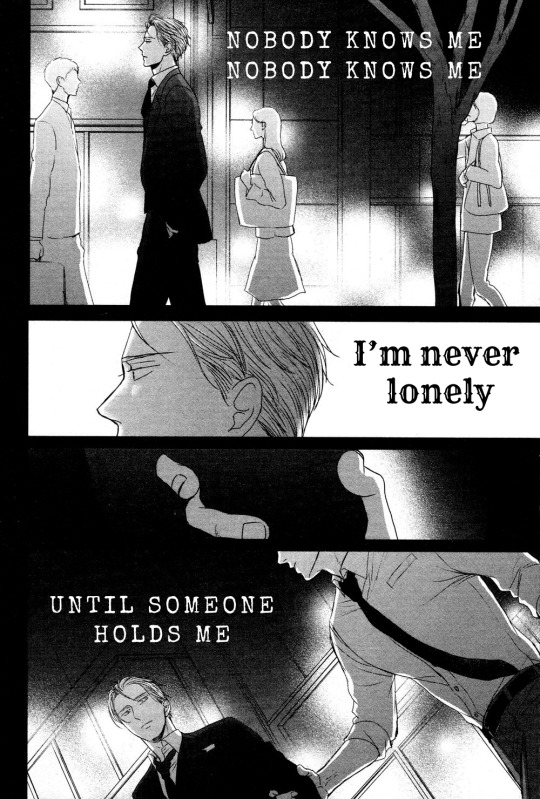
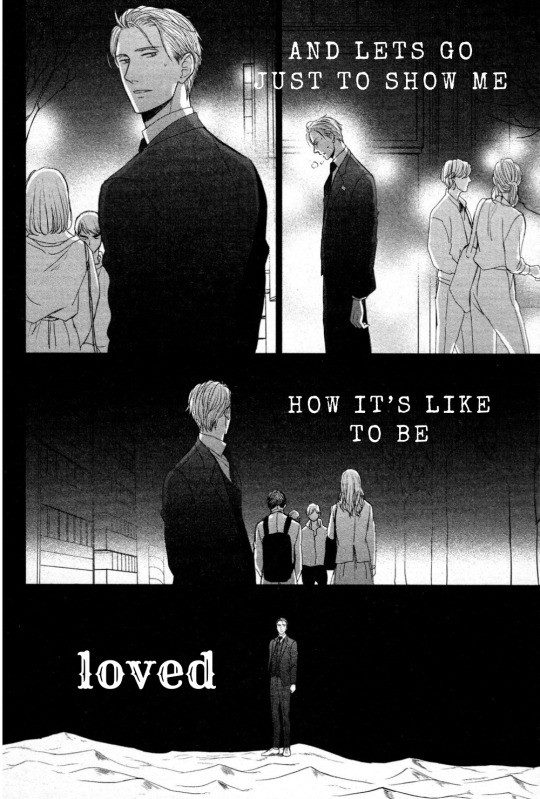
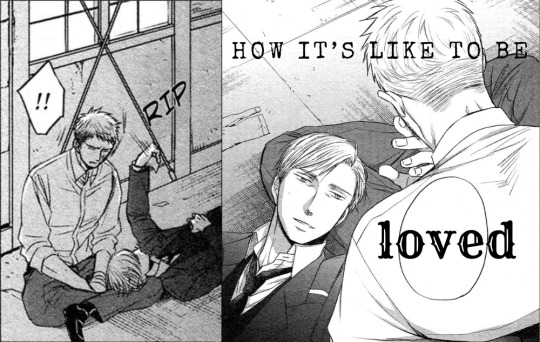
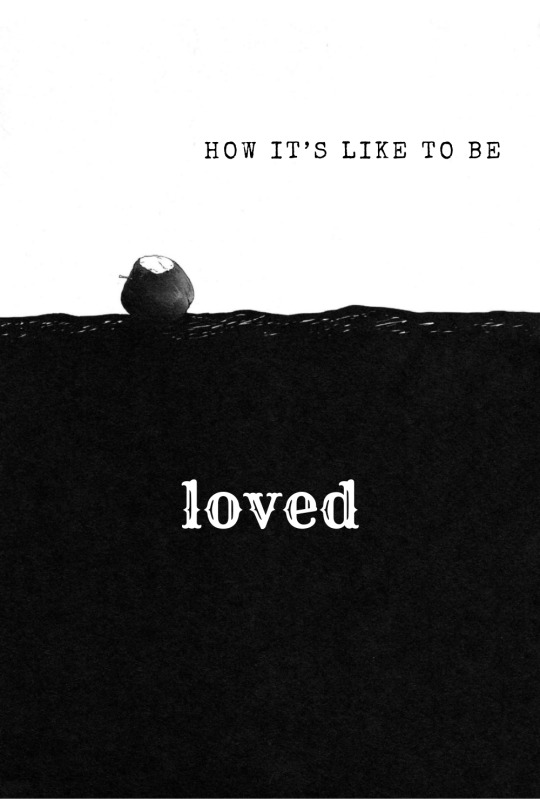
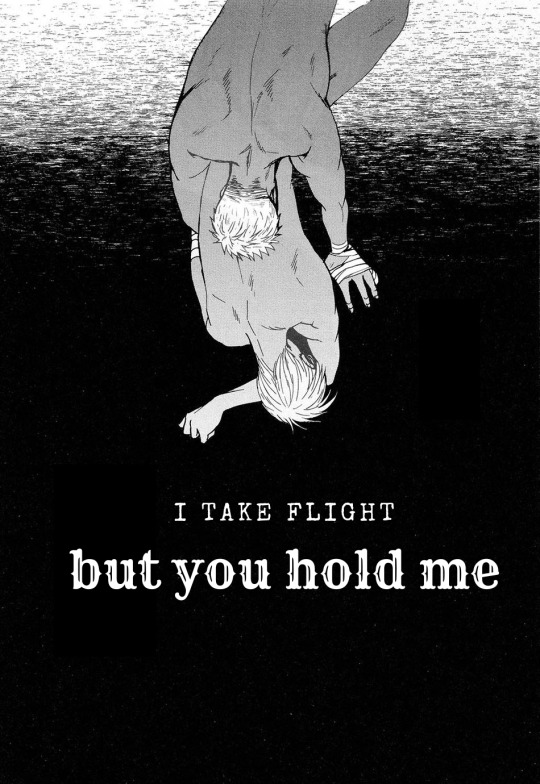
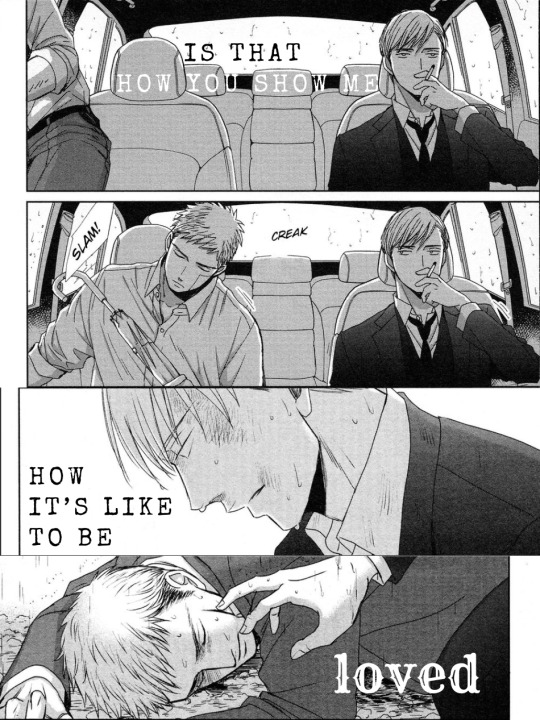

To be loved ~ by Askjell & Aurora
#to be loved#Aurora#Askjell#saezuru tori wa habatakanai#saezuru#twittering birds never fly#囀る鳥は羽ばたかない#yashiro#doumeki chikara#doumeki x yashiro#yaoi bl#yaoi manga#I fucking love both Aurora and Saezuru so much#This can't be coincident#Spotify#yoneda kou
31 notes
·
View notes
Text
By now, a clear pattern had begun to emerge in Hagio’s works. The story will center on a remarkable and strange character who, for one reason or another, seems incapable of so-called “normal” human interaction (and who is usually small, beautiful, and androgynous). But we see this character through the eyes of an unremarkable (but invariably handsome, and often long-haired) young man, unsure of his place in the world, and just trying to muddle through. This “straight man,” usually through arbitrary coincidence, forms a unique bond with the “eccentric.”
The Moto Hagio Interview conducted by Matt Thorn
I light up a Turkish tobacco cigarette which is manufactured in Belgium. It's expensive enough to impress and necessary for placing a punctuation mark of respect in a possibly unruly crowd. I make a big deal of lighting it quite slowly, taking a deep breath with closed eyes, leaning back and blowing the smoke above my companions, because I'm nothing if not considerate. I take care to expose my neck and generally remind everyone of what their dicks are for. I must have done this well because everyone stops talking to watch me. (…) Let me be clear, I do not smoke. It is dangerous both to yourself and others. A leading cause of cancer, heart and respiratory disease, cot death, infertility, puts immense pressure on the health service, is a public nuisance, is economically unsound (although the government approve of it due to the healthy injection the taxes bring to the treasury, but we don't talk about that), is a littering problem, the cause for many house fires, and affects your skin, teeth, hair and clothes. But everyone smokes occasionally for that whisper of hedonism. It's always been this way. It was one of the first subtleties I learned in the secret language of politicians. It says that I am a wild card. My loyalty and morals are for sale, so approach me with an offer, if you have one. All this may or may not be true; I appear to do one thing when I'm actually doing the opposite. My heart is the purest gold and no one can touch it, but I have to be seen to give out invitations. You should always make yourself as accessible as possible to the benefits which can come from it. There are many hidden meanings in everything we do. The choices we make must be made with consideration and care. My doctor assures me that he doesn't even think of me as a smoker.
The Hinterland Doctrine: Those Who Stand For Nothing Fall For Anything by Halfpromise
Ah well. Might as well get it down. I am not sure my joke from earlier landed. Analysis is it then. Yashiro, Doumeki, cigarettes and hierarchy.

The first time Doumeki really noticed Yashiro, as stated in the bonus chapter A flame in the distance, goes like this. Doumeki just caught a glimpse of Yashiro’s back at the office when he is being ordered by his employer to bring the car around. While he is waiting in the driver seat he is musing about his new discovery: he is working for a company that is a facade to illegal loans and presumably other illegal activities associated with the yakuza. He began working in a construction site and was noticed for his build and appearance, now he is a driver and enforcer and just realizing it. Just as he is thinking “I have to get out of this”, he hears Yashiro’s voice. The yakuza boss is exiting the building, Doumeki can see him now from the car. He asks Nanahara for a light and as the cigarette is ignited, Yashiro’s gaze meets Doumeki’s. The flame of the lighter, Nanahara’s gesture, Yashiro’s sensuality and attractiveness: these elements together have Doumeki spellbound. For my own personal reasons, I don’t interpret this scene as “love at first sight”, this is just the first stage of attraction, devoid of any depth or reason. In my opinion, Yoneda offered another scene meant to be interpreted as Doumeki falling in love with Yashiro the person, not the floating imagery of him: that scene being when he loses his shoe while trying to keep up with Yashiro on a crosswalk, while wondering and feeling angry about Kageyama being the recipient of Yashiro’s affection and not returning it. When Yashiro turns around and makes fun of him for being clumsy and losing a shoe, Doumeki is in love, although he probably doesn’t acknowledge it until later when Yashiro is shot.
But the seed is planted earlier, with Doumeki thinking that Yashiro is beautiful. His idealization is short lived when his current employer gets in the car and starts talking about Yashiro with the words Doumeki will recount later to the very same person. Yet Doumeki’s interest stays focused, doesn’t die even after Yashiro does everything he can to prove those harmful words about himself right.
In this very first impression of Yashiro in Doumeki’s mind, we can already see two different elements about smoking that are relevant to the story and world building of Saezuru. The obvious one being the seduction, that careful constructed sexy image built by tobacco companies during a century of direct and subliminal advertising, from Marlboro men to movie stars and from the young bad boys to the femmes fatales. The burning, the lips, the body language, the silver smoke creating allure. A slow burning that promises spice and warmth. Better writers than me can add to it. There are many panels of Yashiro with cigarettes and cigarettes’ smoke that toy with sensual plays and even smoking fetishism: the visual aspects enhanced by the sounds if you followed the manga with the drama cds. If depictions of women smoking were often associated with being receptive to sexual advances and impulsivity, men smoking could signify different things: all the above, but also wealth and power. Because of course. Imported cigarettes or cigars being offered to potential business partners, the intimidation of smoking/breathing deeply and visibly while holding eye contact with another man, and do men love to mix seduction and intimidation in their games and schemes.
No surprise then that in Saezuru the majority of the yakuza men smoke and adopt all the rituals and signifiers of smoking. Nanahara holding a lighter for Yashiro, performing a servile act for his superior is a signal of the hierarchy and the importance of status. Who is the boss needs to be clear and visible. We see the same gesture happening between Misumi and Kurobane from the envious eyes of Hirata. Because lighting a cigarette for someone is intimate, close, reserved for the boss’s most trusted man. Although there is a dominant/submissive aspect to the act, the ritual in itself isn’t an indication of a sexual relationship, but certainly the intimacy and the suggestion are there. In my opinion between Misumi and Kurobane or between Yashiro and Nanahara the most important and valuable element is trust. Kurobane was Misumi’s “other half” in the same manner Nanahara sometimes acts like Yashiro’s wife, it is a relationship with a trusted subordinate, where the power balance is never challenged. A real lover would have a different dynamic, would push to be at least equal and maintaining trust would be more difficult.
So now that I have shared some of my thoughts about smoking and cigarettes, you see why I was feral about the resolution of the cliffhanger between chapters 55 and 56. It meant so much. Doumeki doesn’t offer to light the cigarette for Yashiro, but takes it away and lights it for himself to taste it. You have to take into consideration all the signifiers described above about the position of power and the implications of subordination here. When Doumeki first caught sight of Yashiro, he wanted to get close to an older man in a position of authority he could admire, taking Nanahara’s place. That is why Yashiro was partially right when in chapter 28 he said: “He attached himself to the first thing he saw when he got out of prison and trailed behind it willingly without thought”. Like a baby bird following his parent. After what happened with his real father, Doumeki’s world had collapsed and he was directionless. Yashiro knew and refused to keep him as subordinate, denying him the formalization of a parental relationship through the exchange of sake cups. But now, four years later, Doumeki has found some sort of footing by himself and can confront Yashiro in more equal terms.
And he can also take away the cigarette Yashiro was about to smoke because yet other aspects associated with smoking are addiction and sadomasochism: you know that cigarettes cause harm but you are addicted to the small pleasure of smoking. Yashiro is impulsive, but he manages to balance precariously through his addictions, sex and cigarettes. Doumeki already caused a dramatic change to one of those habits. While still reliving his traumatic past through his relationship with Inami, he no longer can justify that he is doing it because he gains pleasure from it. Doumeki taking away his cigarette at the end of chapter 55 symbolizes this development beautifully. It is bittersweet. Doumeki now is slowly taking possession over one of Yashiro’s addiction. But he needs to get why he is able to do so, what changed?
35 notes
·
View notes
Text
After Yashiro was hit on the head by Hirata, he lost vision in his right eye. There are many examples in manga and anime of a character losing one of their eyes. In a lot of cases this occurred during a very traumatic event that will have significant repercussions in the future and will be the catalyst for a change in the mindset of that character.


In Berserk, Guts/Gatsu loses his right eye as a permanent reminder of the last terrible image he saw through both eyes: symbolically the image is seared into his memory and will always be burnt in the blind eye as an afterimage.
In an article titled “Go For the Eyes: Masculine Bodily Harm in CLAMP”, ai-da-ice wrote: “In both xxxHolic and Tsubasa, CLAMP alludes to ‘memories of the body’, in which the body acts in response to something the mind has forgotten or rejected”. (Source: http://quickand2thepointless.blogspot.com/2013/02/go-for-eyes-masculine-bodily-harm-in.html)
In the anime adaptation of chapter 84 of Shingeki No Kyojin, Hange losing an eye is directly connected to Moblit’s death. At the same time this new condition in both Hange and Levi can be seen as symbolic of the danger of losing foresight to what is going to happen and being unable to plan accordingly. On the other hand, Eren’s self mutilation plays more into the injury to the eye motif, but it is still significant in underlining a lack of an overall view in the pursuit of an ideology or predetermined plan.


There are many more examples that could be made. Therefore, a missing eye or a blinded eye, in Japanese ‘sekigan 隻眼’, as a well known figure of speech in manga, can be read as a representation of something else. Yashiro’s right eye will always be a reminder of Doumeki sacrificing his life to protect him. That image finalized Yashiro’s decision to push Doumeki away from life in the yakuza, a choice that implies the loss of a part of himself. But Yashiro’s blind eye as a memory of the body is an indication of Doumeki as someone never to be forgotten, because catalyst of permanent changes.


101 notes
·
View notes
Text
Yashiro San and Dimorphic Emotions.

Dimorphic emotions are those emotional states in which the sensation experienced does not match its bodily expression.
Dimorphic emotions are expressions that at first glance contradict each other (such as laughing when you are angry, crying with joy, vomiting when you feel pleasure), because the emotion is one but the bodily expression is another.
The function of this brain response is to restore the emotional balance that the person does not consciously achieve due to too intense an emotion (Yes, Doumeki, love). An example of the self-regulation of emotions that psychology studies is the so-called “cute-aggression”, when an aggressive response arises in the face of tenderness, it is not that the person does not register or rejects the affection, but that their brain registers it in a way so intense that by not being able to control it, it emits a response antagonistic to what it really wants to express and in this way the person can maintain its capacity to respond and adapt to a situation (control).
This is a natural mechanism of the brain and does not mean that you are crazy. So Yashiro San simply has a deep need for control and that's why he reacts the way he reacts to love and Doumeki. They can develop through love situations but also due to stressful or traumatic situations in childhood. So, it all makes sense. Doumeki must be a psychologist to deal with our beloved Yashiro-San and it is not surprising that although he wants to hug and love Doumeki, he turns his face away with a kick.
30 notes
·
View notes
Text
When Kageyma's glasses break
From the oneshot about Yashiro and Kageyama in high school, we’ve learnt that Kageyama’s glasses are the symbol of his self-imposed blindness to the world and his non-conformed parts, an external filter called social norms. Taking ignorance, avoidance and conformity as a coping mechanism, he has given up “seeing” with his own eyes, embodied by the lens contact he lost. When Kuga is brought into his life by Yashiro, it takes two times for Kageyama’s mental constraints, aka his glasses, to corrupt, so that he can be finally free to start to figure out, acknowledge, and embrace his true self. Only then can he reach happiness.
The first time the glasses on his face crack is caused by Kuga. One eye is cracked a little.

Kuga is indeed “dazzling” like Kageyama thinks. He resembles Yashiro a lot, except from his straightforwardness and bold spirit when it comes to romance, which Yashiro is tragically unable to exhibit “right” (that’s why Kageyama thinks Yashiro is self-centered). Kuga’s rough arrival in Kageyama’s life cripples his shield, opening a chance for him to emotionally mature to engage in a romantic relationship with men.
For the shield has been weakened, Kageyama feels both indulged and endangered. The deeper he falls in love with Kuga, the more escalating the threat is to him. One day he gets hard tracing Kuga’s scars, the other day he meets up with a woman. Once again, his coping mechanism is re-established to deny the truth about himself, the same way it operated back then in high school with Yashiro. Kageyama’s growth is at risk of inhibition. This time, both Kuga and Yashiro challenge Kageyama’s preference between the long old misery of self-bereavement that keeps him “safe” and the new life with his true self, though it seems so frightening. It’s Yashiro the tragic villain giving the fatal killshot to force Kageyama to move by saying he wants to make Kuga his.

The essence of Eros is the desire to possess. If you’re romantically in love, you’ll get jealous and want that person to be yours, and only yours. Kageyama once almost had Kuga, but he declines the possibility of “them” himself. To deal with an obtuse Kageyama, Yashiro only needs a few cunning words to provoke Kageyama’s sense of regret, which is probably more powerful than love itself. Consequently, jealousy and regret empower Kageyama to break his own mental constraints, palpable in the form of glasses.
In the second time, his glasses break pretty comprehensively in both eyes. Now he can see himself and Kuga without a restrained filter. Now he can see and accept the truth.


Kageyama the dry up old man can finally grow at the age of 36. However, the consequences of his imbalance, maladaptive coping mechanism remain. For forfeiting the world’s true form for too long (~2 decades), his ability to “see” can’t be reclaimed, or at least, his journey is not shown clearly in “Saezuru”. Nevertheless, in compensation, Kuga has become his new contact lens, showing him what he overlooks. Kuga is the new light to his long-blinded eyes.
#saezuru tori wa habatakanai#saezuru#twittering birds never fly#囀る鳥は羽ばたかない#yashiro#kageyama#glasses#don't stay gold#yaoi bl#yaoi manga
32 notes
·
View notes
Text
Yashiro and/ versus Kageyama: The singularity of humanhood
Warning: Wall of text (about 1500 words) (ʘ‿ʘ) (ʘ‿ʘ) (ʘ‿ʘ)
"People ... are full of contradictions. They’re lonely. And then they’re not. They’re missed. And then they are not."
This monologue of Yashiro reveals the reasons why Kageyama and he are unable to forge a romantic relationship. The ways they deal with the outer world and themselves contradict each other, rendering them incompatible. Their respective mental burdens billow whenever they are together during high school. Yashiro confronts his homosexuality head-on, embracing it aloud, while Kageyama conceals it, even from his own awareness. It's a tragic paradox, where two individuals grappling with the same matter yet employing starkly contrasting coping mechanisms, making their interactions all the more painful to witness. However, no one is really at fault. People are just different, living in different universes, which entails the ultimate singularity of humanhood.
Yashiro has always been that observant and astute kind of person, perceptive enough to discern much about others, yet conversely, is taken into account and understood too little by other characters. Seeking for torture, aware of the world's inherent cruelty, Yashiro adopts increasingly questionable behaviors, inviting insults and even physical assaults, and hopefully Kageyama's notice too. This self-destructive persona becomes his armor against past trauma, a role he convinces himself to fully embody, albeit at a cost that may appear excessive to others, leading Kageyama to perceive him as self-centered. Despite the fabrication of his persona, Yashiro is candid about one aspect of himself: his attraction to men, a truth that challenges Kageyama's own understanding of himself.
On the contrary, Kageyama's obtuseness isn't inherent but rather a chosen path in life. Ignorance and conformity are his chosen coping mechanism. He follows the footsteps of his parents by enrolling in med school and becoming a doctor; dodges the “danger” of not being straight by finding a woman whenever somebody forces him to confront his true sexuality. Kageyama is that typical type of person who meticulously adheres to social norms, blending in with his family and the heteronormative world around him. However, this self-protective mechanism also endangers Yashiro whose deepest fear lies in rejection and emotional pain.
In this analysis, I’m going to consolidate Yashiro and Kageyama’s dynamic in two symbolism systems: the perceptions (lens vs glasses) and the defense (umbrellas, 2 vs 1).
1. The perceptions (lens vs glasses)
Lens
Lens is typically associated with observation, perception, and worldview. Yashiro’s act of stealing Kageyama’s lens case manifests his desperate yearning to be "seen" by his crush. Through various actions, Yashiro strives to show Kageyama who he is as a person and his aspirations for their relationship: he attends Kageyama’s father’s funeral, shares deeply personal information with Kageyama, and even sexually assaults his classmate to provoke a reaction from Kageyama.

As Yashiro takes the lens case, his inner monologue speaks, “But if he ever rejects me, it’ll probably hurt me. This is… obviously not… something I’m used to feeling.” Yashiro is acutely aware of the potential emotional toll of pursuing this unfamiliar feeling. Despite the risks of rejection and mental anguish, he still bravely proceeds for the desire to escape his perpetual solitude. All he truly seeks is someone who cares about him. Actually, he is asking for just a tiny meager.
Nevertheless, Yashiro's intense persona, shaped by childhood trauma, becomes too much for Kageyama to handle. Consequently, Kageyama consistently avoids and evades the possibility of being gay, which Yashiro persistently presents to him. In fact (or figuratively), Kageyama has given his answer before Yashiro even mentions about the matter.
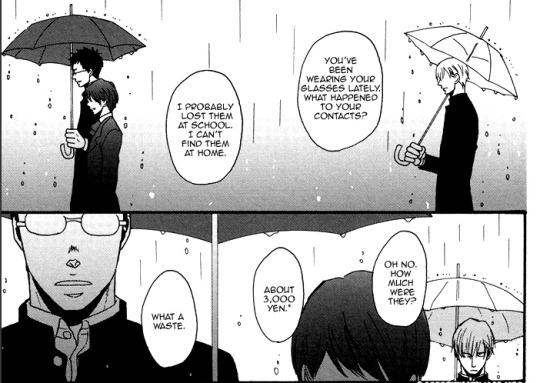
This rainy scene involving Kageyama, his girl, and Yashiro conveys a profound message about Kageyama's stance. Though the simple dialogue is about Kageyama losing his lens, the underlying theme is about him losing his ability to truly "see" because he chooses not to. He deliberately avoids "seeing" Yashiro to avoid confronting the uncomfortable truth about himself and his sexuality. The girl's remark, "What a waste," goes beyond the monetary value of his loss; it hints at the greater losses Kageyama can imagine at that moment. He loses the world in its true form and his true, authentic self - which navigates us humans throughout life. He reserves himself by never letting that self interact and be reflected from people, leading to a gradual decline in his ability to empathize and grow emotionally. Ironically, his attempt to protect the self eventually ends up destroying it. That's why he grows into such a dense and apathetic bloke.
Glasses
I believe the glasses on his face are meant to be sarcastic. His eyes are not presented in the above panel, instead only his glasses. Glasses are typically a tool for better vision, yet in this particular case, become a symbol of his self-imposed blindness. As Kageyama can’t “see” the world with his own eyes, he chooses to rely on external aids – the social norms, to filter the world for him. A man with glasses is actually a blind man.
2. The defenses (umbrellas and 2 vs 1)
The visual storytelling in these panels is masterful, capturing the intricate dynamics and stark contrasts between the characters and their internal struggles. Here we have black vs transparent umbrella, being accompanied vs alone under the rain. Let’s not forget about the rain – the befallen suffering, and in this particular scene, it could be interpreted as the looming threat they pose to each other or the mental barriers they avoid confronting. Yashiro doesn’t want to be rejected and get hurt, while Kageyama is reluctant to acknowledge his homosexuality, given the societal stigmas.
The umbrellas
I once wrote an analysis including my interpretation of the transparent umbrella Yashiro gives Aoi, if you’re interested, please scroll to the end of this post to read. To summarize that part, that umbrella represents Yashiro’s deep empathy and the wish to end the suffering of somebody who experiences the same trauma he endures. Transparency stands for “being seen”, or at least, in this scene, the wish to be. With all normal to absurd acts, despite the risks, Yashiro is trying to make Kageyama realize who he is as a person (yet of course, acting out on his façade simultaneously). On the contrary to Yashiro, Kageyama’s black umbrella symbolizes his coping mechanism, blocking any outcast that possibly derails him from the safe uniformity. Yashiro, the friend behind him, becomes the epitome of the abject, representing Kageyama's own fear of straying from social norms.
2 vs 1
Additionally, the contrast between Kageyama being accompanied and Yashiro walking alone adds more weight to the scene.
Kageyama's aversion to be odd out drives him to seek validation through external factors, such as his relationship with women, to anchor himself firmly within social norms, which also echoes in “Don’t stay gold”. By being with someone, Kageyama subconsciously affirms his belongingness and shields himself from ostracization.
On the other hand, Yashiro, though broken and “twisted beyond repair”, is risking facing his utmost terror of being emotionally damaged. Walking alone signifies the will to keep himself survive without the buffer of external relationships or societal validation. It must have taken him aggrandizing bravery to reach that point of vulnerability, risking facing his utmost terror of being emotionally damaged.
As Yashiro persists, Kageyama withdraws further. Ultimately, Kageyama’s avoidance calls for Yashiro’s ultimate fear of rejection. The risk becomes too overwhelming for Yashiro to endure, prompting him to halt his pursuit. Eventually, they both settle into a common medium of ceasefire, which is friendship. While Kageyama maintains a superficial, pitying and somewhat indebted concern for Yashiro, Yashiro secretly harbors his unrequited love that spans a painfully long period, nearly two decades.
3. The singularity of humanhood
The oneshot closes with the scene where Yashiro cries at the balcony while clenching Kageyama’s lens case.
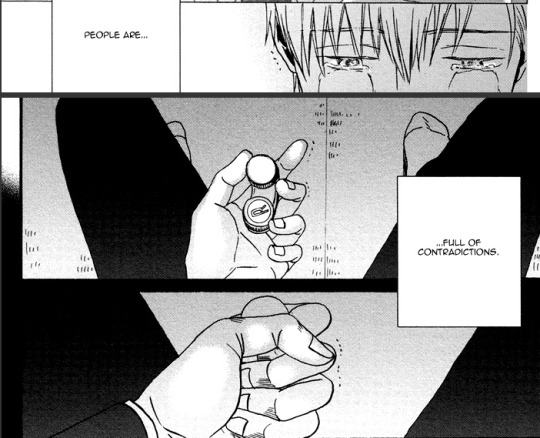
“People are… full of contradictions. They’re lonely. And then they’re not. They’re missed. And then they are not.”
Yashiro and Kageyama’s encounter invites an opportunity for a break from their homeostasis of solitude, yet eventually, it plunges them deeper into their initial mental state. Despite being friends and their shared attraction to men, they are universes apart, operating on different systems. They can't find solace from each other. They’re both lonely and yet they’re also not. They both exist, yet they also don't.
Yashiro has always been alone. However, he resembles a stray cat. A stray cat only becomes pathetic if adopted, petted, loved and then abandoned. If Yashiro is never rejected, he is never pathetic or truly lonely. He may be abjected, have nothing or nobody, but he retains the one constant: himself, the only ally that can accompany, protect and keep him survive.
On the very contrary, Kageyama, in conforming to societal expectations for safety, sacrifices his authenticity and inner connection. He may be with others, but he can’t be with himself. Kageyama is so empty inside. Living a life without an authentic self can be just as tragically lonely as physical solitude.
Now who really is the lonely one? Who will be missed and who will not? Yashiro the ever outcast with an overwhelming persona but nobody is taking him into account? Or Kageyama the self-deprived, while conforming to social expectations, lacks a genuine identity?
Read my other analysis including the transparent umbrella of Aoi here:
#saezuru tori wa habatakanai#saezuru#twittering birds never fly#yashiro#囀る鳥は羽ばたかない#analysis#rain#umbrella#yaoi manga#yoneda kou#kageyama#lens#glasses#being seen#coping mechanism#singularity#lonely#漂えど沈まず、されど泣きもせず#yaoi bl#oneshot
21 notes
·
View notes
Text
Yashiro’s Eyes.. An eye of hopeless despair and an eye of unbearable pain

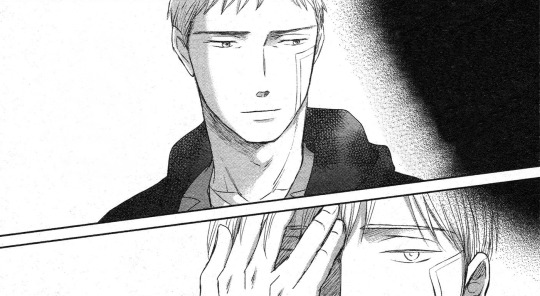
The wish to forget; and the wish to remember forever
The desire to let go; and the desire to engrave his image in his memory
The numbing of pain; and the need to seek insufferable pain.
The hope to fly away; and the despair of the prison and burden forever weighing down on him.
163 notes
·
View notes
Text
Doumeki's irezumi
Irezumi (入れ墨, lit. 'inserting ink') is the Japanese word for tattoo, and is used in English to refer to a distinctive style of Japanese tattooing.
In chapter 53, Doumeki's back tattoo is revealed to be a "celestial maiden". Typically, irezumi incorporates motifs such as dragons, Buddhas, samurai, koi fish, and more, each carrying specific cultural and symbolic meanings referred to as wabori (和彫り). Intrigued by Doumeki's tattoo, I went asking if Doumeki’s tattoo is identified as any wabori and received responses suggesting it could represent either Nuwa (女媧) or Benzaiten (弁才天), given the details of snake and the stone in the goddess’ hands. After some research, Nuwa (女媧) seems to be more aligned with the story than Benzaiten (弁才天). However, I still present both of them and their possible interpretations in the story.

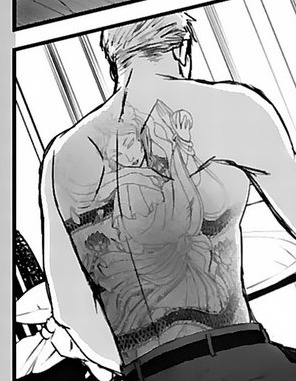
I. Nuwa (女媧)
Nüwa, is a mother goddess, cultural heroine in Chinese folk religion, Chinese Buddhism, Confucianism and Taoism. She is credited with creating humanity from clay by the river bank and repairing the Pillar of Heaven. Let’s focus on the myth of “repairing the Pillar of Heaven”.
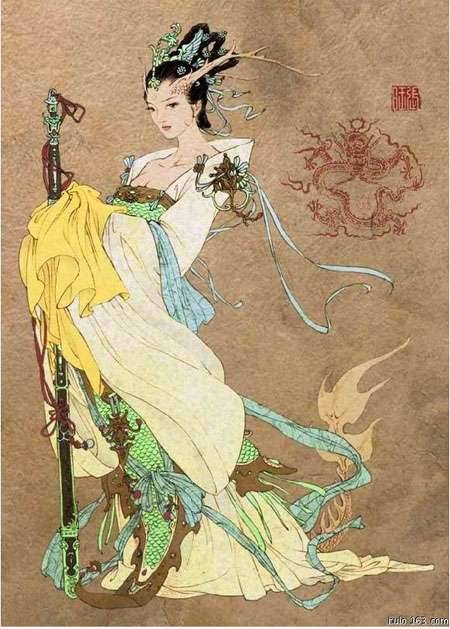
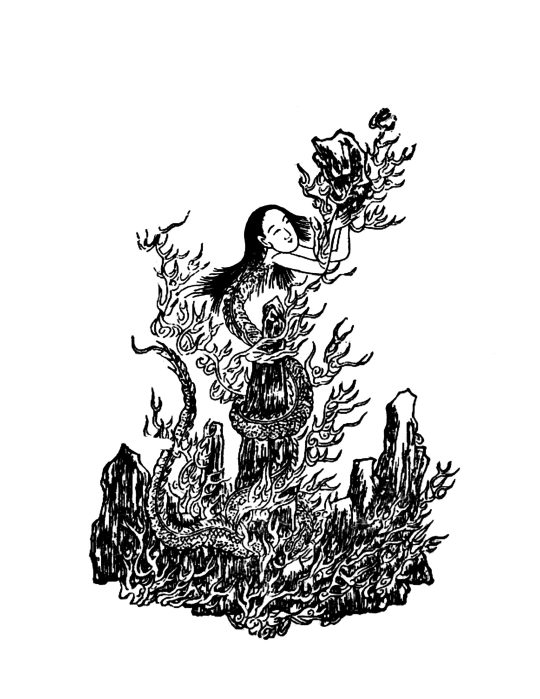
The world of the first beings was very different from ours now. The earth was just in its infancy and was only separated from the sky by four very large pillars. One day, Gonggong (龔工), the god of water, and the god of fire, Zhurong (祝融) became locked in a massive battle that would determine the ruler of heaven. Gonggong, who was motivated by evil, ultimately lost the fight and crashed his head against Buzhou mountain—one of the four pillars holding up the heavens. The earth began to tremble and the pillar collapsed and ripped a hole in the sky. At this point, the earth was completely in tatters from Zhurong and Gonggong’s epic battle. Fires had scorched the earth, water was pouring incessantly from the hole in the sky. The ancient Chinese historian Sima Qian (司馬遷), recorded the following account of Nüwa’s heroic deed: “Hereupon Nüwa melted stones of the five colours to repair the heavens, and cut off the feet of the tortoise to set upright the four extremities of the earth. Gathering the ashes of reeds she stopped the flooding waters, and thus rescued the land.” From that moment on, the water in the heavenly palace no longer cascades on earth to cause harm to the people.
In mythology, Nuwa played a crucial role in repairing the sky hole and preventing heavenly water from pouring onto the earth. As rain – the water from the sky, the befallen suffering, is one of the main themes of Saezuru, the parallel is pretty evident. Given Doumeki’s persistence to stay in the yakuza world and his decision to have a wabori that big on his back, he is doing everything he can to manifest his devotion to stay on Yashiro’s side, end his suffering and protect him from any potential harms, even though up to the newest developments of the story, it doesn’t seem likely at all. They’re both confused and hurting each other.
II. Benzaiten (弁才天)
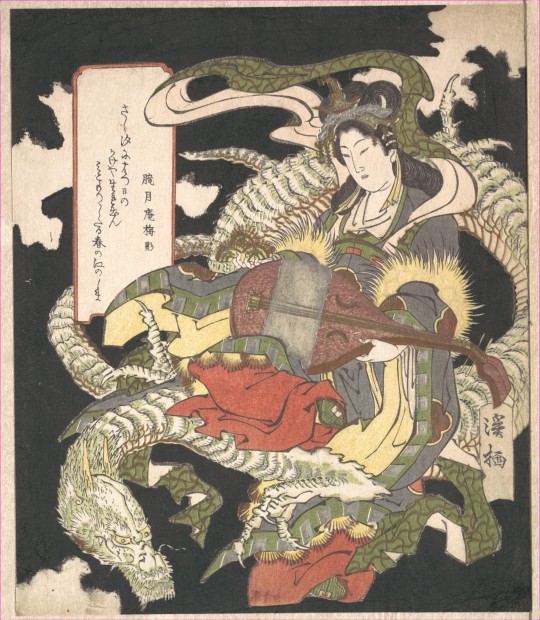
Benzaiten ( 弁才天 ) is the “goddess of eloquence" who originated mainly from the Hindu Indian Saraswati, goddess of speech, the arts, and learning. While Benzaiten retains many of the Indic attributes of Saraswati (as patron of music, the arts, eloquence, knowledge), she also has many unique aspects, roles and functions which never applied to the Indian goddess. As such, Benzaiten is now also associated with dragons, snakes, local Japanese deities, wealth, fortune, protection from disease and danger, and the protection of the state. Benzaiten is depicted in a number of ways in Japanese art, one of which is her portrait wielding a sword and a wish-granting jewel (cintāmaṇi). Eloquence and wish-granting? I haven’t been able to draw the parallel to Saezuru yet.
So I’d stick to the interpretation that Doumeki’s tattoo is Nuwa.
#saezuru tori wa habatakanai#saezuru#twittering birds never fly#doumeki chikara#囀る鳥は羽ばたかない#irezumi#celestial maiden#nuwa#mythology#yoneda kou#yaoi manga#tattoos
44 notes
·
View notes
Text
Great info abt Noh and great interpretation of Yashiro's act with both of his hands removing the mask.
Fireflies can only be seen at night
Less and less to know what will happen to Doumeki and Yashiro in that empty room. Having survived the shock of discovering that Doumeki did have a tattoo, as always I couldn't stop thinking about the mystery so I started to do some research.
After reviewing information about yakuza tattoos, I believe in the theory that Doumeki has been getting this tattoo, better known as IREZUMI, for quite some time and that the last retouching that was done helped Yashiro realize, due to the injuries, that he was tattooed While theories of what Doumeki got tattooed abound everywhere, I want to focus on the deeper meaning of the act itself.
First of all, with the tattoo reveal, Doumeki finally showed that he was serious when he said that he would do anything to stay in Yashiro's world, just look at his reaction upon finding out.

The last scene of the first arc shows us Doumeki plunging into the darkness going down the hospital stairs, then we see how he assures Amou that he is willing to go against his own principles in order to be close to "that" person and finally the statement he makes in the sake bar: "my time and my BODY belong to me", by the way, this is one of my favorite phrases. But words are carried away by the wind, so what better tangible display of his tenacity than getting a tattoo.
In Japanese culture, tattoos have always had a connotation related to the criminal world, so it is not uncommon for the yakuza not to display this art publicly, but there is something much deeper in the concept of privacy of Japanese mafia tattoos. Horiyoshi III, one of the most legendary and favorite tattoo artists of the yakuza, explains that he does not believe that they get tattoos to say that they are loyal to a group, rather it has to do with the ninkyō concept that means helping the people below you, therefore, when a yakuza gets a tattoo, he would want to show that he has the strength to help the weak. If we take this to saezuru I couldn't agree more because Doumeki finally had to reinvent himself to gain strength if he wants to protect Yashiro in any way.

Horiyoshi III (in the image) also explained that the yakuzas only tattoo themselves in places of the body that are protected by their brand new suits, tattooing hands and neck would be prohibited by the afore mentioned. With this information I think I can understand Yoneda's vision of not showing Doumeki tattooed until the precise moment in the story arrived, the final rapprochement with the person he loves. Why would Doumeki have to be showing us as readers something that is so private to him?
This last thing made me remember that I had a book called Junichiro Tanizaki's Praise of the Shadow. The author through different disciplines such as architecture, art, design, etc. It shows us that fascination that the Japanese have since time immemorial for what cannot be seen so clearly. One of the examples that interested me the most was when he recounted how beautiful the Noh theater of yesteryear was where there weren't too many advances in lighting. The old theaters barely illuminated left enough, the development of the works of the moment, to the imagination of the assistants.
When I read this I couldn't help but relate it to Yashiro's phrase "being a yakuza is like being an actor", every time I read these cartoons I thought about contemporary actors but what if Yashiro was talking about traditional Noh theater actors. These actors are almost completely covered with their clothing, only their hands and neck are visible because their faces cannot be seen either because of the masks they use to represent the different characters.
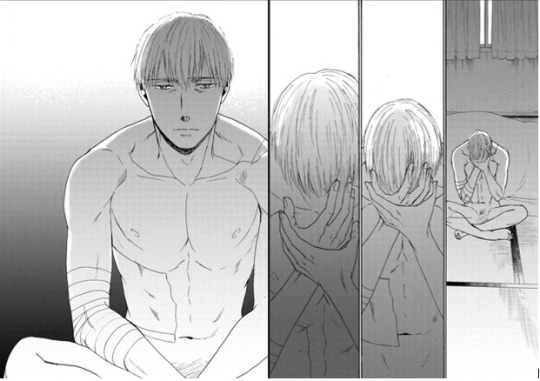
You don't know how excited I was when relating these facts and thinking about the moments in the manga where we discovered Yashiro wearing or removing that mask. On the other hand, Doumeki has always paid close attention to what Yashiro says and after several years it is not evident that he has become quite an actor to the point of deceiving many of the readers at some moments in the story.
My conclusion about the meaning and importance of the Doumeki tattoo is that Yoneda, as always, has masterfully known how to use Japanese tradition, delicacy and mystery to precisely show us everything under a dim light where each reader has to discover this story for himself because the beauty of all this is as Horiyoshi III said: "Fireflies can only be seen at night."
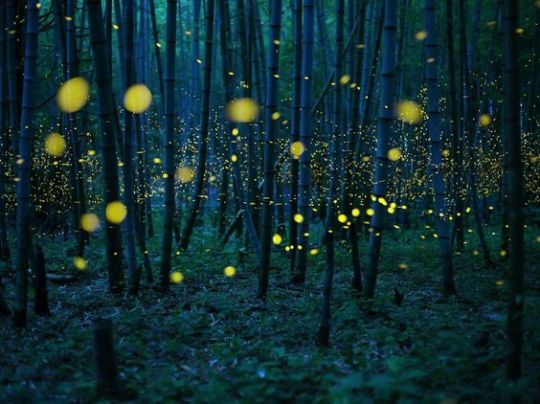
You know, if there are problems with the text, it's Google translator's fault. Thank you very much if you read this far.
78 notes
·
View notes
Text
In my opinion, the man-woman stuff is rather Yashiro's identity crisis than dysphoria. His stepfather's ramblings during rape had sabotaged his identity before he had any chance to figure it out himself. Deep inside he's so confused, not knowing whether he is a man or a woman. His body is definitely a man, but he likes men and prefers being penetrated, which is considered perverted in the homophobic world he's living. However, if he were a woman, then his stepfather's words would be true, which resurrects the trauma in its full brunt on him. "Man" and "woman" are so strictly archetyped in his head that there's no grey area in between. To him, men - tough, women - gentle. This may also contribute to why he is so repulsive against gentle sex or being treated with tender care, because it would make him a woman. He never knows his love for men and desire for gentle care don't make him any less of a man. In such a cruel and stereotypical world, he never knows, and it's purely tragic.
sorry for overthinking a sex scene (it will happen again) but it always bothered me that in chapter 10 yashiro cries during the threesome. you can count the number of times he's shown crying on one hand, and all of them are significant in some way. except for that one, right? or at least that's what it seems like at first.
looking at the scene with the knowledge of later chapters (specifically 25 and 27) and taking into account all the parallels between the unnamed man and doumeki, i prefer to read it as yashiro having a flashback similar to the one he had while having sex with doumeki for the first time. there is absolutely nothing concrete to support this and i don't necessary thing that it's intentional reading of the scene, but it does fit surprisingly well, all things considered.
you don't get to see yashiro's perspective or what he's feeling specifically at that moment. he doesn't say anything after he starts crying and his internal monologue stops right before. the man makes the assumption that yashiro's reacting that way because "it feels so good", but there's no confirmation of that and no other instances of him crying for that reason, at least not that we're shown. most importantly, it's the same excuse that yashiro uses later with doumeki. i don't think i can believe that the man's assumption was correct while the direct parallel to that is an obvious lie.
why that time specifically, though? it's been established that what yashiro is seeing can strongly affect his mental state. sunlight shining through a window at the wrong angle. a ceiling that looks a bit too familiar. and, in this case, a view of a woman's back while there's a man behind him. it's an uncomfortable parallel and i'm not sure what picking up on it says about me, but trauma is uncomfortable, and it's not like saezuru shies away from it, so neither should i. it's also worth noting that this chapter is from the same volume where you're shown the flashback for the first time, and specifically the version of it where you can see yashiro's mother.
lastly, yashiro's initial reaction to the flashback in chapter 25 makes me feel like it's not necessary a rare occurrence. which would make sense, considering how trauma works. "���あ、どうして今 | ah, why now?" to me both reads and sounds (if you listen to the drama cd) somewhat… casual, for the lack of a better word? it's not that he's surprised about the flashback itself, it's the fact that he's having it despite things being different this time, that he can't really escape it, that he's "broken beyond repair". which is for another conversation entirely, but the point is - i do think that yashiro's been dealing with it for majority of his life and simply got better at managing it over the years, or rather, convincing himself that he has it under control. he's only 19 at the time of the threesome, it would make sense that he'd be more shaken up by the flashback then than he is at 36 and not be able to fully hide it.
again, i don't necessary think that this is the intended reading. for all i know, it could be as simple as "it felt that good". but it fits, and it works, and things are rarely that simple in saezuru, so for my personal interpretation of the story i'm choosing to stick with it
63 notes
·
View notes
Text
Umbrella vs. Rain: The Driving Forces of Saezuru (3)
Note: my analysis relies heavily on visual elements
III. Aiai gasa (相合傘) - Under the shield of love
"相合傘 - Aiai-gasa" is a combination of the word "相合 - Aiai" - doing something together, and the word "傘 - gasa" - umbrella. Literally, it refers to the act of two people sharing an umbrella. However, as the word "Ai" is homophonic with "愛 - Ai" - love, "Aiai-gasa" connotes a derivative meaning: Love Umbrella. In "Saezuru", empathy and love are the umbrella that shields characters from the rain (or I believe so).
Yashiro vs. Mother & Child
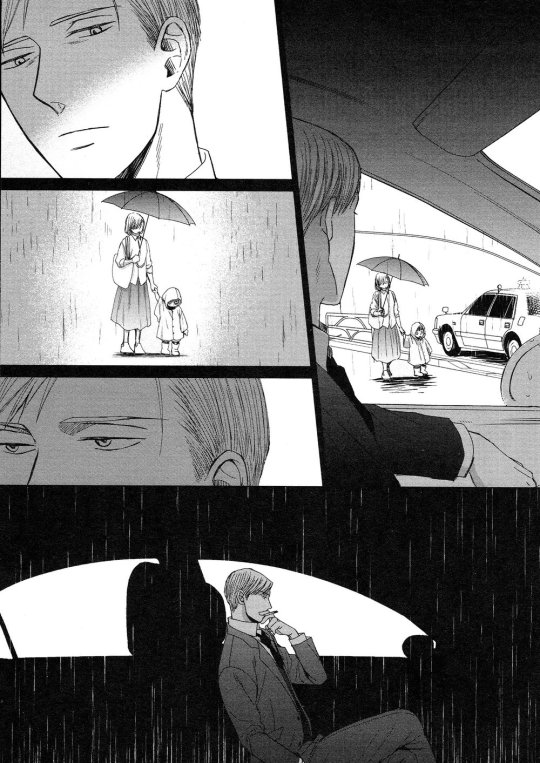
The five panels on this page vividly embody the adage "A picture is worth a thousand words." Following Yashiro's forceful removal of Doumeki from the car, a profoundly expressive and iconic scene unfolds. The stark contrast presented is striking: Yashiro isolated in the car versus the Mother & Child duo outside, together under the rain. While Yashiro remains sheltered within the car, impervious from the rain, Mother & Child rely solely on an umbrella for protection. Yet side by side, the prowess of their bond shines through against the glooming backdrop. Their love acts as an impenetrable shield, leaving them unscathed. In stark contrast, Yashiro, who has just pushed away the person he loves and loves him back for mutual protection, finds himself alone. Despite the physical safety of the car, the rain metaphorically pierces through him in the darkness. It’s not the umbrella itself, it’s love that defends people against the rain. Yashiro has never had love before, but as soon as he has, he’s got no other choice than to let it go. That look in his eyes gives a mix of tragic resignation to his fate, the paradoxical coexistence of envy over and disdain for love, and the determination to give up love.
Fortunately, Doumeki refuses to give up on Yashiro, despite his cruel words. He quickly returns, bringing along an umbrella and water for medicine. His determination to stand by Yashiro's side and shield him is palpable. As soon as he enters, the car is brightened up and the rain retreats back to be outside of the car.
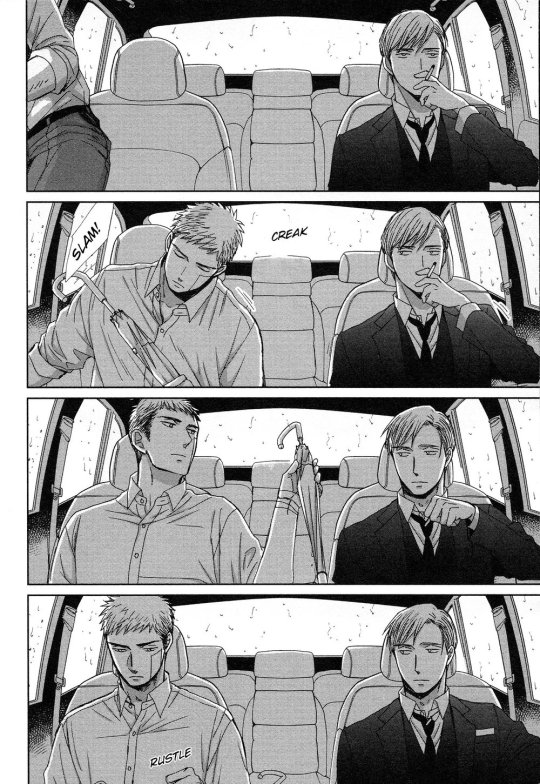
In this scene, Doumeki's arrival with the umbrella not only shields Yashiro from the rain's darkness but also symbolizes his loving presence guarding Yashiro off from his turmoil.
Although Yashiro may not yet be brave enough to acknowledge or confront his feelings, his expression subtly transforms from a frown in the first panel to something softer in the last. This instant change reveals the other side of Yashiro genuinely doesn't protest Doumeki's return, hinting at a hidden vulnerability beneath his tough exterior."
2. Moratorium

This cover is the scenery illustration of an extra where Yashiro has Doumeki run an errand to buy him an umbrella. For Yoneda sensei never half-asses anything, I'd like to take an approach regarding the characters' setting and the story's developments on this painting.
This marks the beginning of Yashiro and Doumeki's journey towards each other, as Doumeki endeavors to stand by Yashiro's side. Amidst the pouring rain, their bare heads stand out starkly in a sea of umbrellas, emphasizing the pain they both endure. In the bustling crowd, Yashiro remains motionless, a solitary figure amidst the chaos. The red light he is leaning against represents his childhood trauma and the yakuza world. Literally and metaphorically, Yashiro can't go even if he wants to. Yashiro's relaxed posture against the crimson glow signifies his reluctant acceptance of his date, a tragic resignation to his circumstances.
On the other side, Doumeki opts not to shield himself with the umbrella he carries and dashes to Yashiro with big strides. This bold act underscores Doumeki's unwavering commitment to protecting Yashiro, even at the cost of his own comfort and well-being. He willingly discards himself. That's why it doesn't end well.
3. Not yet Aiai gasa (相合傘)
When Doumeki returns, Yashiro's intuition clicks when he sees only one umbrella with him, but screws the idea of Aiai gasa right away by forsaking Doumeki drenched in the rain.
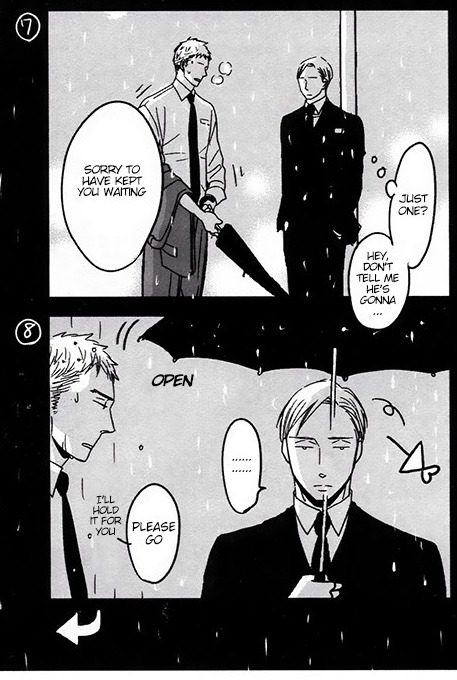

The 7th and 8th panel summarizes Saezuru until the end of the Hirata's arc - Yashiro pushes him away through assault, while Doumeki endures it all to remain by Yashiro's side. Aiai saga is meant to be two people under the umbrella, not one. Ironically, despite their deep affection and fierce desire to protect each other, their relationship falters due to a lack of mutual commitment to being together. Another significant contributing factor is their profoundly low self-esteem: Yashiro, feeling undeserving, violently pushes Doumeki away to protect him, while Doumeki, undervaluing his worth, tolerates mistreatment and violence for Yashiro's sake. In this sense, they both push Doumeki away, unable to bridge their emotional barriers.
In the 9th panel, Yashiro blames Doumeki for his tardiness. While Doumeki is indeed late, it's evident that it's not his fault. His arrival into Yashiro's world comes after Yashiro has endured immense suffering alone for a long time, leading to a coping mechanism that rejects Doumeki's presence. However, Doumeki's entry into Yashiro's life marks the end of the Moratorium. Yashiro can now begin to move forward, although the process is slow and painful, signifying a gradual progression towards healing.
By all accounts, in their complicated case, love love alone is not sufficient. Acceptance, self-appreciation, and the mutual wish to be together are essential components for Aiai gasa to work for them.
4. Aiai gasa (相合傘) - Under the shield of love
I'll be positive saying that Yoneda sensei has hinted at their happy ending in this poster for the Rain event, or at the very least, a phase where they accompany each other out of love.
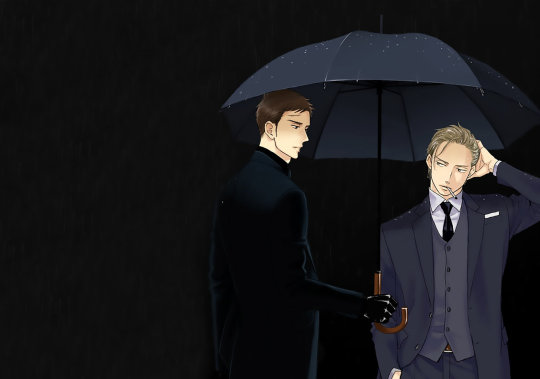
This is Doumeki and Yashiro post-time-skip. The image of them under the umbrella signifies a mutual desire to be together at last. Doumeki holding the umbrella for Yashiro, who is already slightly damp from rain droplets, symbolizes Doumeki's belated but meaningful presence in Yashiro's tumultuous life. This time, Yashiro allows Doumeki to take care of him, indicating a shift in their dynamic. Doumeki's actions also suggest a growth in his self-esteem, from nothing to something.
Their interaction speaks volumes. Despite Yashiro's sulky expression and bombastic side eyes, Doumeki meets his gaze directly. This subtle interaction hints at their ongoing communication and mutual efforts to understand each other better.
Under the shield of love - Aiai gasa, they are navigating their complexities. Under the shield of love, anything is possible, I believe. The mutual understanding, if they successfully arrive, would not only empower them but also serve as a shield, safeguarding and freeing them from their birdcage.
Read the previous parts here:
Part 1:
Part 2:
#saezuru tori wa habatakanai#saezuru#twittering birds never fly#yashiro#doumeki chikara#doumeki x yashiro#囀る鳥は羽ばたかない#analysis#rain#umbrella#yaoi manga#yoneda kou#moratorium#モラトリアム
61 notes
·
View notes